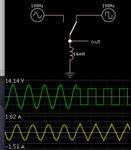Follow along with the video below to see how to install our site as a web app on your home screen.
Note: This feature may not be available in some browsers.
There's no thing like "square wave reactance". Reactance is only defined for sinusoidal excitation. The current waveform observed with a square wave voltage across an inductor is a triangle not a square wave. If you calculate the ratio of inductor voltage and current with square wave, you get different results for RMS, peak-to-peak or average rectified value. Need to specify the question clearly.
Determine current and voltage waveforms for the problem of interest, explain what you consider as reactance or impedance.
Quite generally impedance Z = V/I, how do you measure V and I?
Whow, now you are bringing in complications. I'm just writing "V" and "I", without further qualification. Consider some kind of average values, e.g. RMS.Thats incorrect, there are time differences in the values
Any AC causes an inductor to make an impedance, even a square wave. My question is extremely clear and obvious, you just misappropriated it.

I understand from your question that you want to get the transfer function of a pure inductor when it is excited by a square wave. So, we should define the transfer function first: Is it the ratio between the voltage and current (the impedance) in the frequency domain?Whats the easy way to obtain inductor impedance fed with square wave? It cannot simply be ωFL since afaik thats only applicable for sine waves.